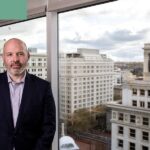Accountants learn how to be advisors and consultants as technology automates traditional bookkeeping.
Chris Ueeck recently had five students from his son’s high school shadow him at his office. Ueeck is a principal at Brenner & Co., a public accounting firm in Salem that was established in 1946. As he talked with students about his industry, he discovered that initially they viewed accounting as old-fashioned, boring even.
“I think a lot of students just have this old-school idea that accounting is getting shoved in a corner office, staring at a wall and just putting numbers in all day, every day,” says Ueeck.
The reality is much different. It is true, when Ueeck began his career 25 years ago, that a large portion of the job included manual entry, whether for a client’s payroll or tax filing.
But in the past five years, public accounting firms across the globe, including the dozens here in Oregon, are undergoing big changes. Technology is driving accountants to learn new skills and develop different services, effectively overhauling their firms’ practices.
This means companies like Brenner & Co., which has approximately 30 employees, are making notable technological investments and are providing increased professional development for employees.
Public accountants see this shift as a professional win and feel poised for the continuing transformation of their industry. “I think the accounting firms are recognizing the changes,” says Ueeck.
“More of the practice is getting your head out of the books, reviewing the numbers and advising.”
Until just a few years ago, the accounting sector remained steadfast in how it operated, exempt from the innovation rampantly reshaping other industries.
Today everything from analytics software to sophisticated enterprise resource planning and crystal-clear video telecommunications are propelling the accounting sector fully into the digital world.
This year international firm KPMG — which has about 230 employees in its Portland office — announced it will spend $5 billion over the next five years on technology and innovation. This includes data science, cloud-based platforms and client-facing applications.
“Up until maybe five years ago, although there were pieces of technology advancement, largely computers were still just used as a way to document something more efficiently,” says Carey Wendle, KPMG Portland managing partner. “We now use computers to really be almost like another team member.”
Large firms like KPMG are already incorporating cloud-based applications and other software into their business. These technologies have automated conventional tasks such as data entry, categorization, accounts payable and receivable, and reconciliation.
And thanks to high-definition video conferencing, accountants save on travel costs while still conducting face-to-face meetings. This also allows firms to meet more people, including outside of the state, and work with businesses in real time.
“Professional service firms and accounting firms a lot of times mirror the business world at large. So, as our clients have increased their pace of change and [are] using more technology tools, they are expecting us to do those things,” says John Donohue, partner at Moss Adams Portland, which has 214 employees. (Moss Adams also has offices in Eugene and Medford.)
These technologies are time-savers, too, says Kate Othus. Last April Othus launched DataDx, a cloud-based platform that collects and analyzes financial and health data for medical clinics. Her inspiration for the program came from her experience as a partner at Aldrich Advisors.
She says the reporting techniques were cumbersome and required a lot of back-and-forth communication with physicians’ busy offices. “We had to make sure we had the right information,” she says. “This saves our clients time.” DataDx is in physician offices along the West Coast and in New Jersey and Nevada.
In addition to automated entry, programs like DataDx provide accountants with real-time data processing as they transition away from solely preparing documents based on past transactions.
“The profession is saying, ‘I’ve got access to incredible information that I never had before, where I can help the business make much smarter decisions,” says Stephanie Peel, a professor of practice in the Lundquist College of Business School of Accounting at the University of Oregon.
Peel, who worked as a public accountant at PricewaterhouseCoopers for nearly 30 years, says students also have access to these cutting-edge programs in the classroom, and young graduates bring their digital native skills to firms as new hires.
While this technology blitz has made daily work easier for accountants, it hasn’t eliminated them. “When we sit and talk about advances in technology, I think there’s this erroneous conclusion that, all of a sudden, there’s less work or that we don’t need the people,” says Ueeck. “You still always need that human level of oversight.”
A May survey of 3,000 accountants worldwide found that business consulting now accounts for 17% of services offered, according to Sage, a market research company
As software relieves accountants of time-consuming responsibilities, they’re free to perform higher-value services such as data analytics, specialty consulting and risk management.
Businesses today are not simply hiring public accounting firms for traditional tax preparation or simple bookkeeping — they have come to expect insight and analysis from firms.
“At the end of the day, what people want is peace of mind and to be able to focus their time on what’s going to move the business forward,” says Jason Staats, a principal with Brenner & Co.
For many small businesses, accountants also become an organization’s chief financial officer as they take on increased consulting roles. “Your typical small business can’t justify or afford a CFO,” says Ueeck.
“We can spend more time with them, giving them that higher, CFO type of advisory, like helping them with interpreting their financial statements, giving them goals, telling them where they were spending too much.”
Accountants in 2020 also specialize in a specific industry to better accommodate their clients. “You have to become a specialist to have an impact,” says Robert Adrian, the practice growth advisor at Jones & Roth.
“We just don’t have generalists anymore. We have to be experts in the space that we are passionate about.”
Adrian adds that at Jones & Roth, its approximately 100 employees are encouraged to pursue specialties. For example, the firm — which has offices in Eugene, Hillsboro and Bend — concentrates on medium-size construction companies, medical clinics and dental practices, both in Oregon and across the U.S.
Over at Moss Adams, Donohue says the firm created cybersecurity teams to offer consulting and analysis around IT systems for clients.
These new roles for accountants also mean that some firms are able to charge more for their advisory services than traditional bookkeeping.
“The value proposition and impact of advisory services is much higher, so the fees tend to be higher,” says Adrian. “Private clients, nonprofits and businesses are willing to pay higher fees if our successful impact provides a positive return on investment.”
Ueeck says at Brenner & Co., traditional bookkeeping comprises only 25% of the company’s practice structure, but he adds that the company did not increase or decrease its rates when incorporating new technologies.
Necessary critical-thinking skills are being taught in accounting classes to prepare the next generation of accountants to also be advisors.
“There’s judgment involved, there’s interpretation involved, and that’s the role. That’s what we’re trying to teach them now, to go beyond the bookkeeping part of it,” says Michele Henney, an accounting professor at the University of Oregon School of Accounting.
With the advent of technology and the transformation of services, public accounting firms are simultaneously investing in professional development for their employees. “CPAs traditionally haven’t been trained to be strategic advisors,” says Adrian. “They’ve been trained to do compliance work.”
Firms that want to keep pace with the demand for consulting services are prioritizing and offering training for employees. Adrian says Jones & Roth provides training on financial management and planning, tax strategy, and more for the specific industries in which they work.
Moss Adams has a library of on-demand resources for its employees at every level, including for consulting, assurance, tax and client-service support.
And at KPMG, Wendle says all employees do between 40 and 80 hours of training each year. In January the firm debuted a new $450 million, 55-acre training facility in Florida.
A lot of the training is technology based, but the global firm offers rotations at one of its offices in 152 countries; Wendle says one of its Portland employees is temporarily working in India on back-end technology.
Firms are also being thoughtful about whom they hire. As services evolve and expand, different positions are now available, including in computer engineering and data science.
Still, public accounting firms face the challenge of attracting and sometimes retaining talent. With Oregon’s low unemployment rate — 3.9% in November 2019 — this isn’t unique to the professional services industry.
But accountants say this is not a new problem; it’s a competitive career field and new graduates have plenty of options when choosing where to go.
Henney, who also serves as the student engagement coordinator, says accounting students at the University of Oregon are exposed to the different options a career in accounting can serve.
The School of Accounting has a local chapter of Beta Alpha Psi, a national organization for accounting students, which meets weekly and brings in guest speakers and local professionals for its 40 student members.
“We’re trying to show the variety of what you can do with a degree in accounting,” she says. “Everybody needs an accountant. Whether it’s for a nonprofit or a governmental entity or a for-profit business, there’s a place for folks to land.”









